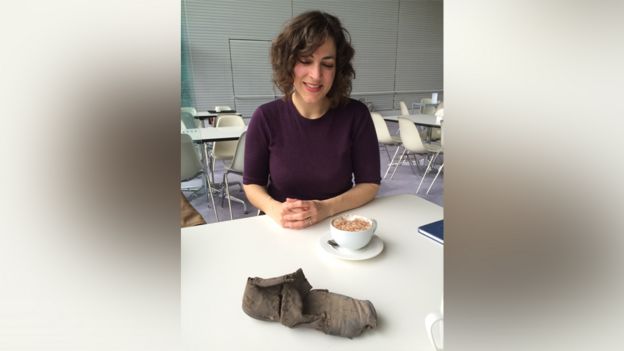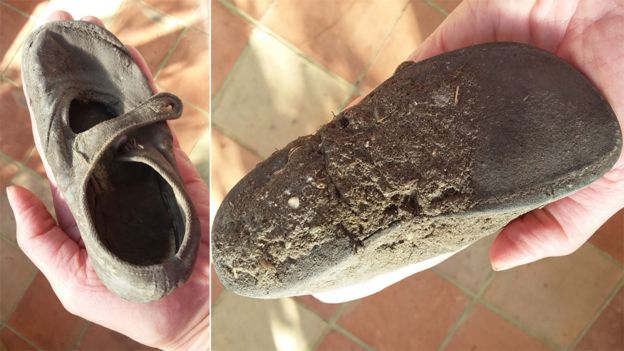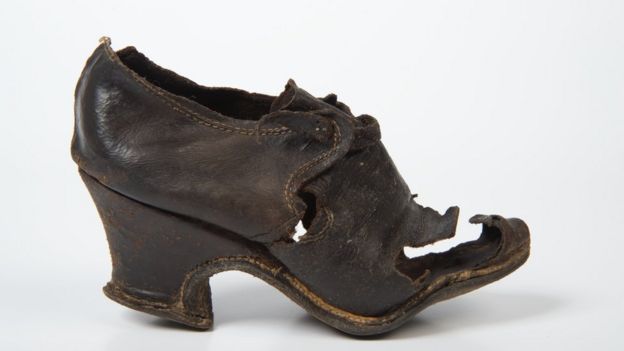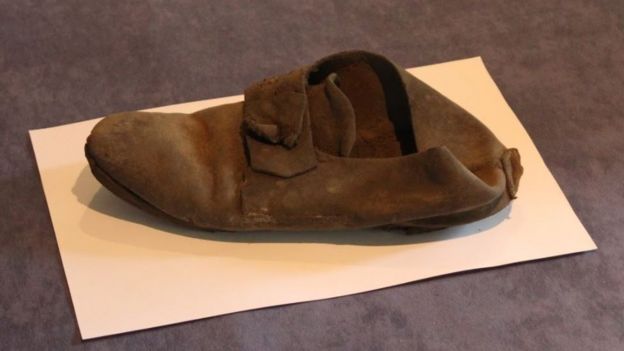maximus otter
Recovering policeman
- Joined
- Aug 9, 2001
- Messages
- 13,934
In 2014, Laura Potts was renovating her Georgian home in a village near Norwich when she made a visit to check on the builders' progress.
"It was late afternoon, that golden hour with the sun coming in through the glass," she said.
"And I looked over and saw something on the windowsill.
"It was a shoe."

The small, patched and worn woman's shoe had been discovered in the pocket of a chimney wall by a plumber, who had left it out for her to see.
Feeling "very excited", Ms Potts posted a photograph of the find on the intranet at work. As a media relations manager at the University of East Anglia, she was in the right place.
History professor Malcolm Gaskill replied with a theory - the shoe had probably been left there as a decoy to lure "witches" away from the home.
"In the early modern period, people also believed in demons, ghosts, elves, goblins - but witches were the most frightening because they were in human form," he said.
Worst still, they were "usually someone living close by - your neighbour".
The solution, he explained, was "everyone" protected their homes against evil by hiding the shoes - like an early form of home insurance.
His "best guess" for why shoes were chosen is they mould to shape, so might be considered "imprinted" with the "character and essence" of the wearer.

Alison Norman's shoe, found in a chimney, came with a large lump of mud and grass as if had been taken off a child's foot just before concealment.

This woman's shoe, which dates from 1675 to 1699, was found in a wall in Ely Cathedral
Reasons for concealment probably differed over time, according to historian Ceri Houlbrook from the University of Hertfordshire.
She said: "In earlier centuries, it might have been about protection from witches or the devil, one theory proposes that the shoes were intended to act as lures for witches, spirits, and other supernatural threats.
"The theory is that the evil force believes the shoe to be the person, attacks the shoe instead, and becomes trapped inside it. But more recently I think maybe they were intended to be time capsules.
"Or maybe the builders were doing it as a type of joke."
It might have been a workman who concealed a heavily-worn man's buckled shoe at St John's College, Cambridge, during an 18th Century redevelopment.

The shoe discovered at St John's College, Cambridge is a straight - designed to be worn on either foot. Left and right shoes were reintroduced from the 1790s onwards.
It was uncovered during renovations in 2016, concealed behind panelling between a fireplace and chimney in what had been the master's rooms.
The extent of the custom is recorded in the Hidden Shoe Index at Northampton Museum, set up in the 1950s by former curator June Swann, who realised the shoes were not just discarded or lost, but had actually been placed.
It lists just under 3,000 shoes found in properties from the Shetland Islands to the Isles of Scilly, with the greatest number being from the south-east of England.
The museum also holds 250 found shoes, the oldest dating to the 1540s and from St John's College, Oxford.
Current curator Rebecca Shawcross said the earliest hidden shoe discovered in the British Isles was found behind the Winchester Cathedral choir stalls, installed in 1308.
She said she receives two or three notifications a month from as far afield as the US, Canada and Australia.
http://www.bbc.co.uk/news/uk-england-northamptonshire-41507752
maximus otter
"It was late afternoon, that golden hour with the sun coming in through the glass," she said.
"And I looked over and saw something on the windowsill.
"It was a shoe."

The small, patched and worn woman's shoe had been discovered in the pocket of a chimney wall by a plumber, who had left it out for her to see.
Feeling "very excited", Ms Potts posted a photograph of the find on the intranet at work. As a media relations manager at the University of East Anglia, she was in the right place.
History professor Malcolm Gaskill replied with a theory - the shoe had probably been left there as a decoy to lure "witches" away from the home.
"In the early modern period, people also believed in demons, ghosts, elves, goblins - but witches were the most frightening because they were in human form," he said.
Worst still, they were "usually someone living close by - your neighbour".
The solution, he explained, was "everyone" protected their homes against evil by hiding the shoes - like an early form of home insurance.
His "best guess" for why shoes were chosen is they mould to shape, so might be considered "imprinted" with the "character and essence" of the wearer.

Alison Norman's shoe, found in a chimney, came with a large lump of mud and grass as if had been taken off a child's foot just before concealment.

This woman's shoe, which dates from 1675 to 1699, was found in a wall in Ely Cathedral
Reasons for concealment probably differed over time, according to historian Ceri Houlbrook from the University of Hertfordshire.
She said: "In earlier centuries, it might have been about protection from witches or the devil, one theory proposes that the shoes were intended to act as lures for witches, spirits, and other supernatural threats.
"The theory is that the evil force believes the shoe to be the person, attacks the shoe instead, and becomes trapped inside it. But more recently I think maybe they were intended to be time capsules.
"Or maybe the builders were doing it as a type of joke."
It might have been a workman who concealed a heavily-worn man's buckled shoe at St John's College, Cambridge, during an 18th Century redevelopment.

The shoe discovered at St John's College, Cambridge is a straight - designed to be worn on either foot. Left and right shoes were reintroduced from the 1790s onwards.
It was uncovered during renovations in 2016, concealed behind panelling between a fireplace and chimney in what had been the master's rooms.
The extent of the custom is recorded in the Hidden Shoe Index at Northampton Museum, set up in the 1950s by former curator June Swann, who realised the shoes were not just discarded or lost, but had actually been placed.
It lists just under 3,000 shoes found in properties from the Shetland Islands to the Isles of Scilly, with the greatest number being from the south-east of England.
The museum also holds 250 found shoes, the oldest dating to the 1540s and from St John's College, Oxford.
Current curator Rebecca Shawcross said the earliest hidden shoe discovered in the British Isles was found behind the Winchester Cathedral choir stalls, installed in 1308.
She said she receives two or three notifications a month from as far afield as the US, Canada and Australia.
http://www.bbc.co.uk/news/uk-england-northamptonshire-41507752
maximus otter

